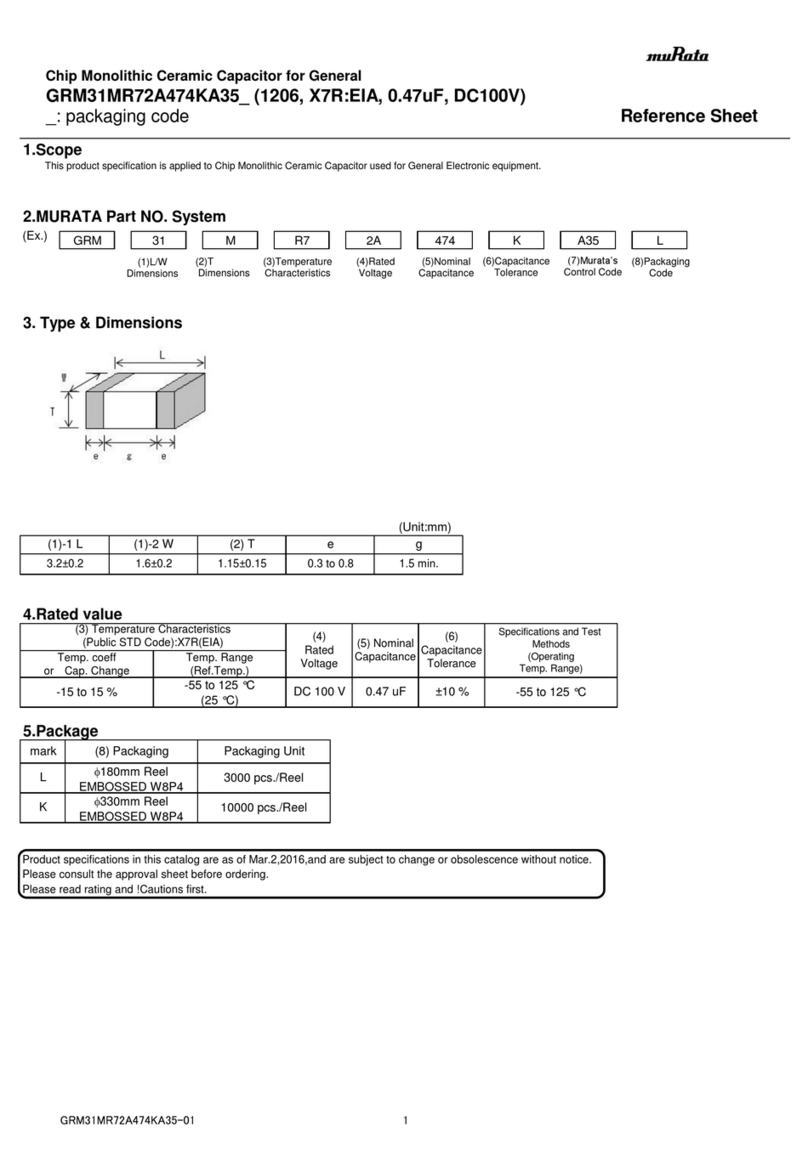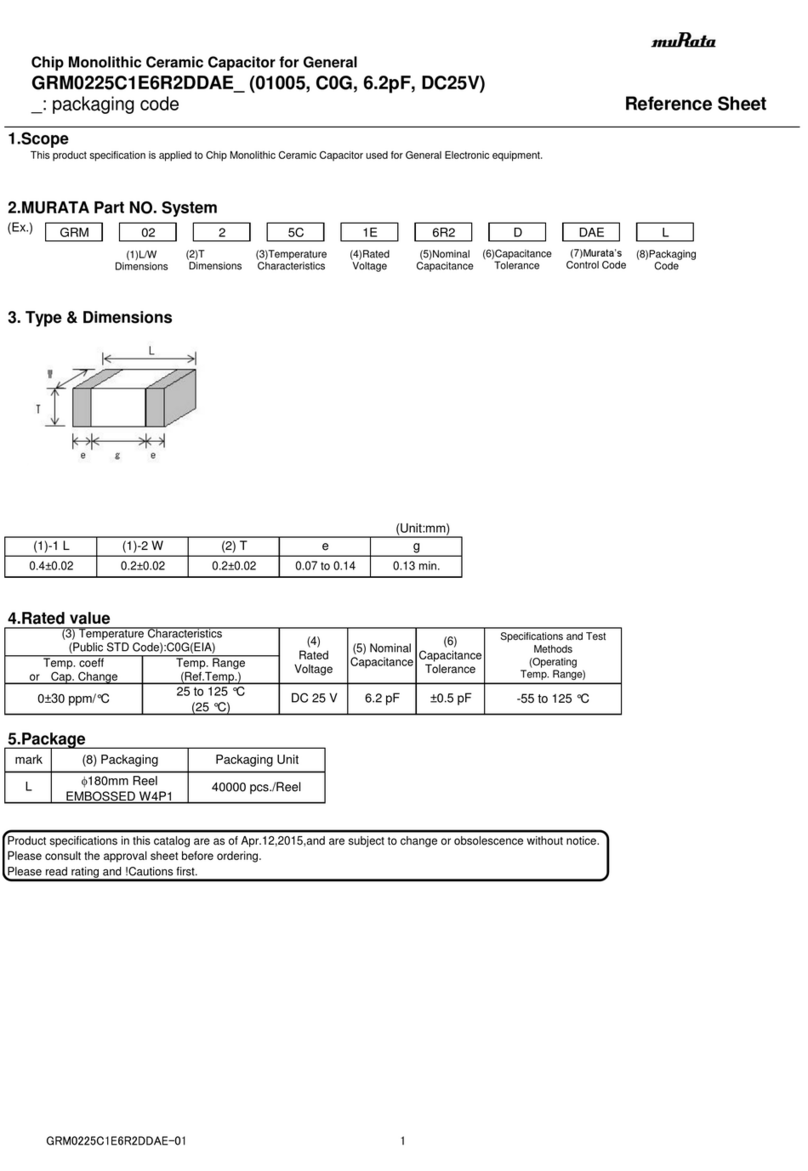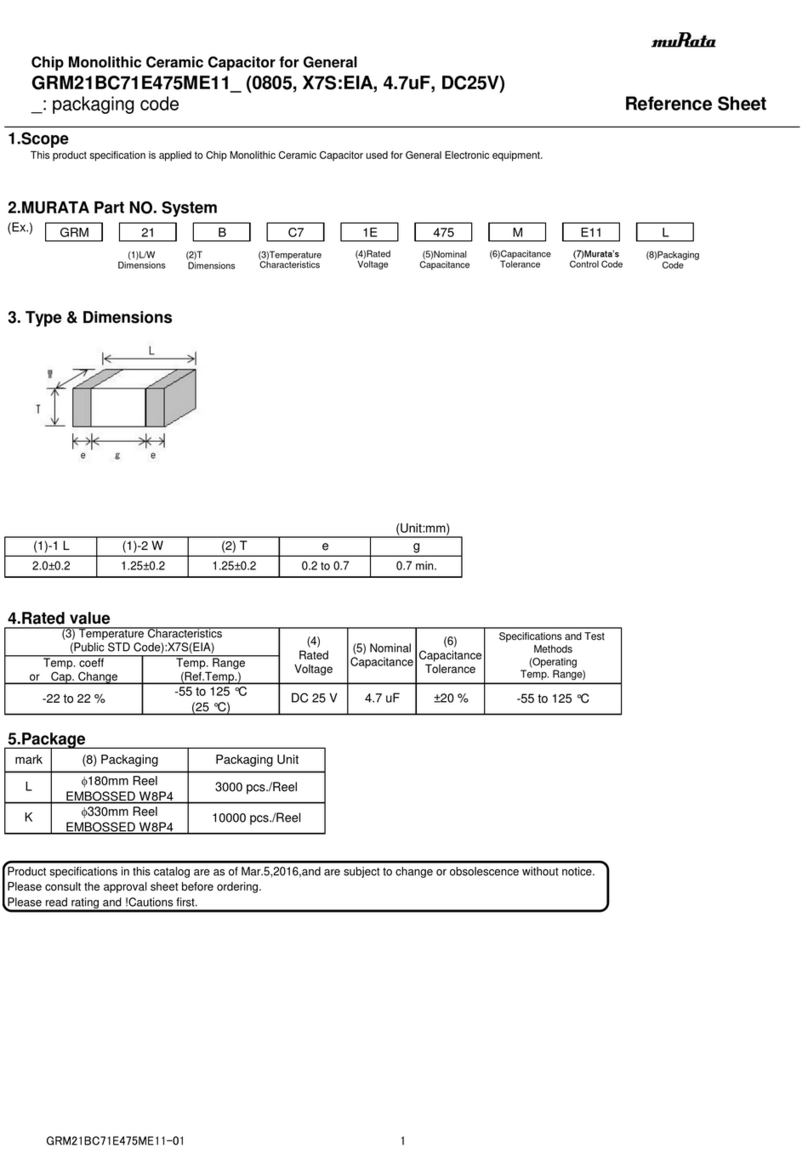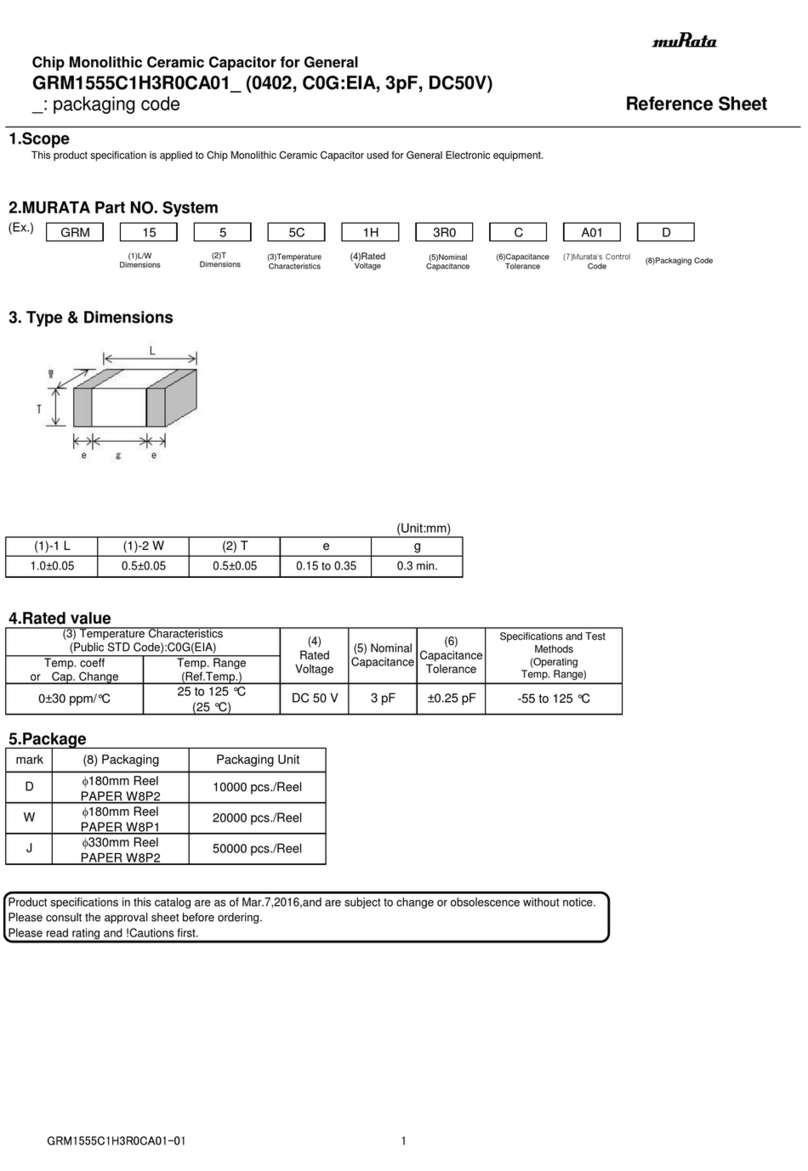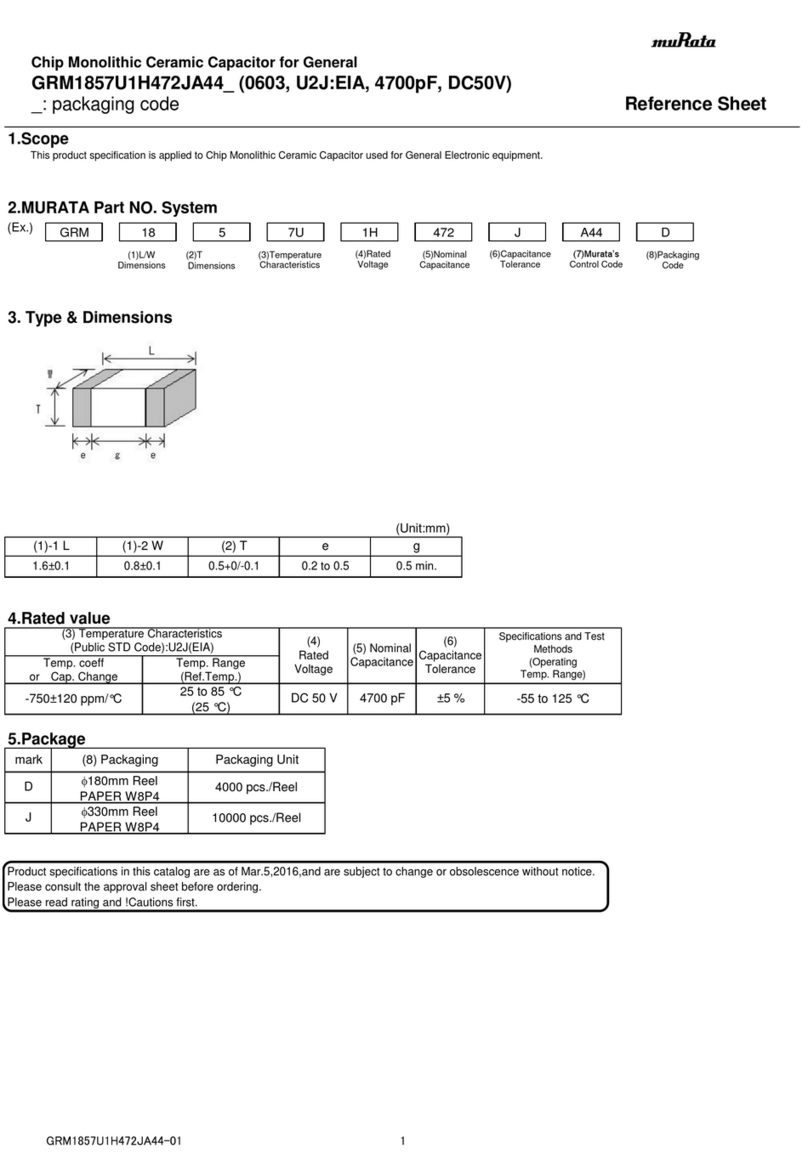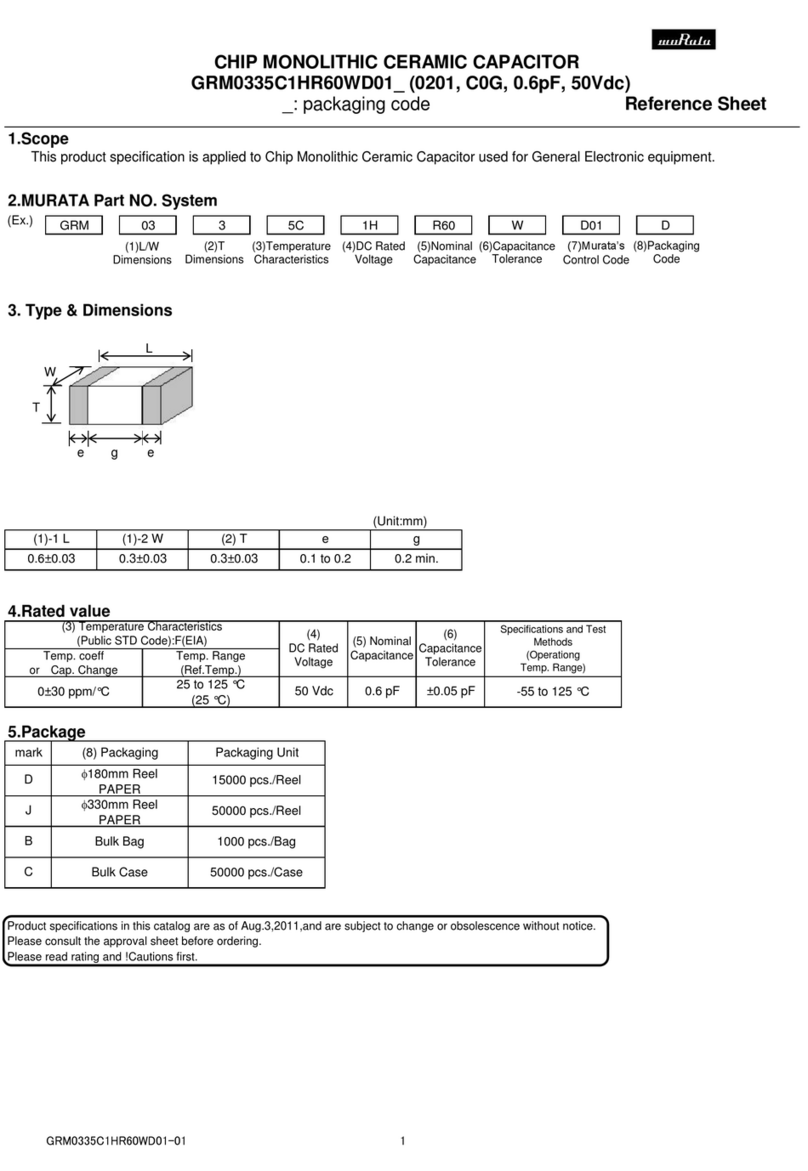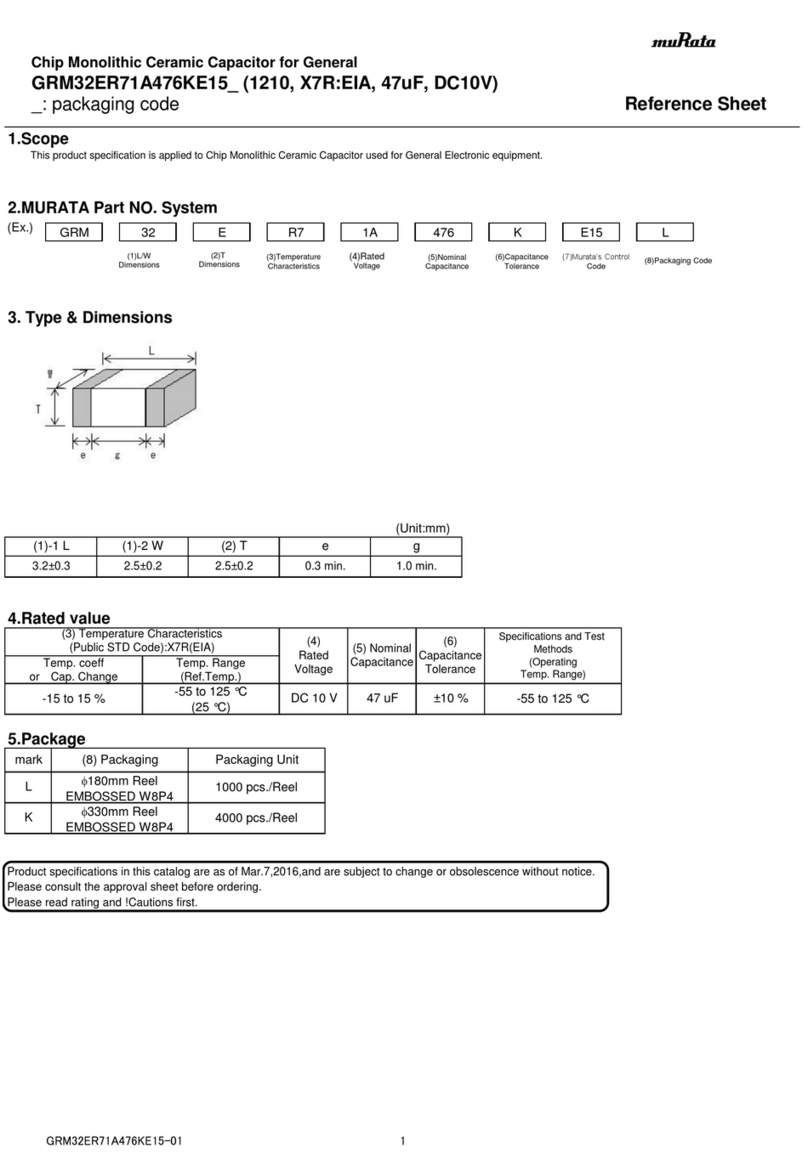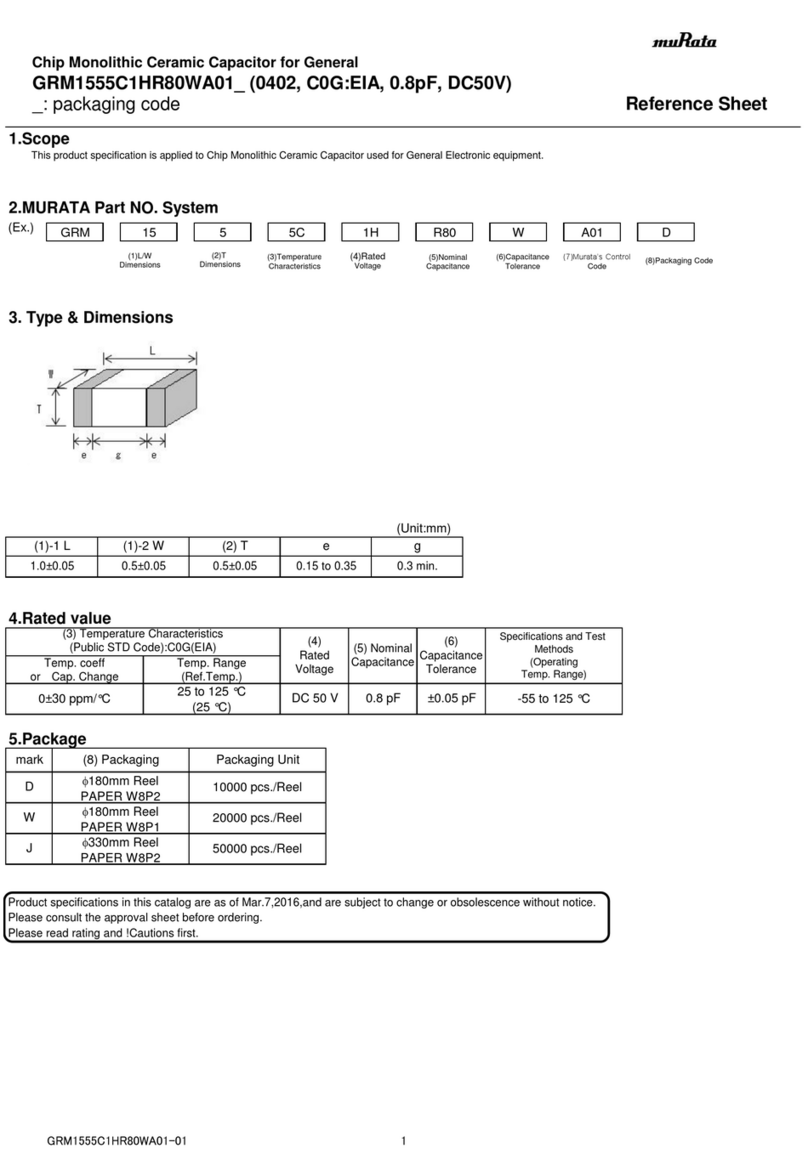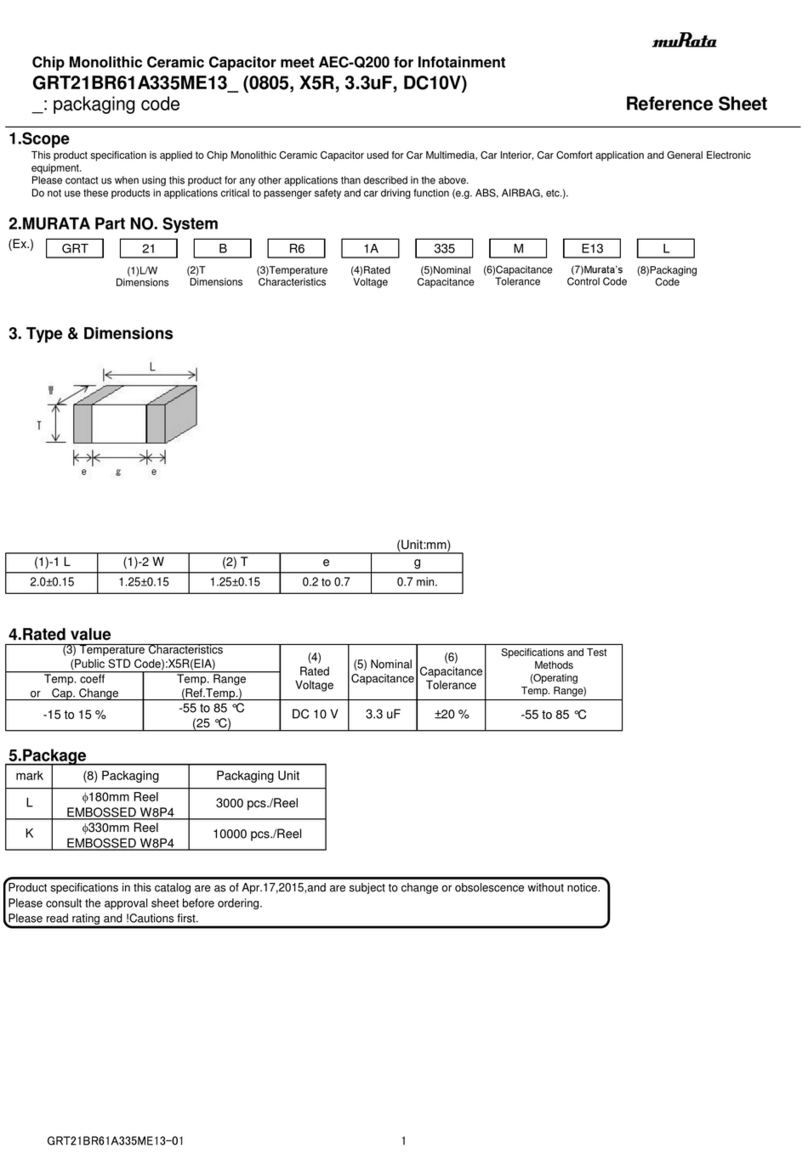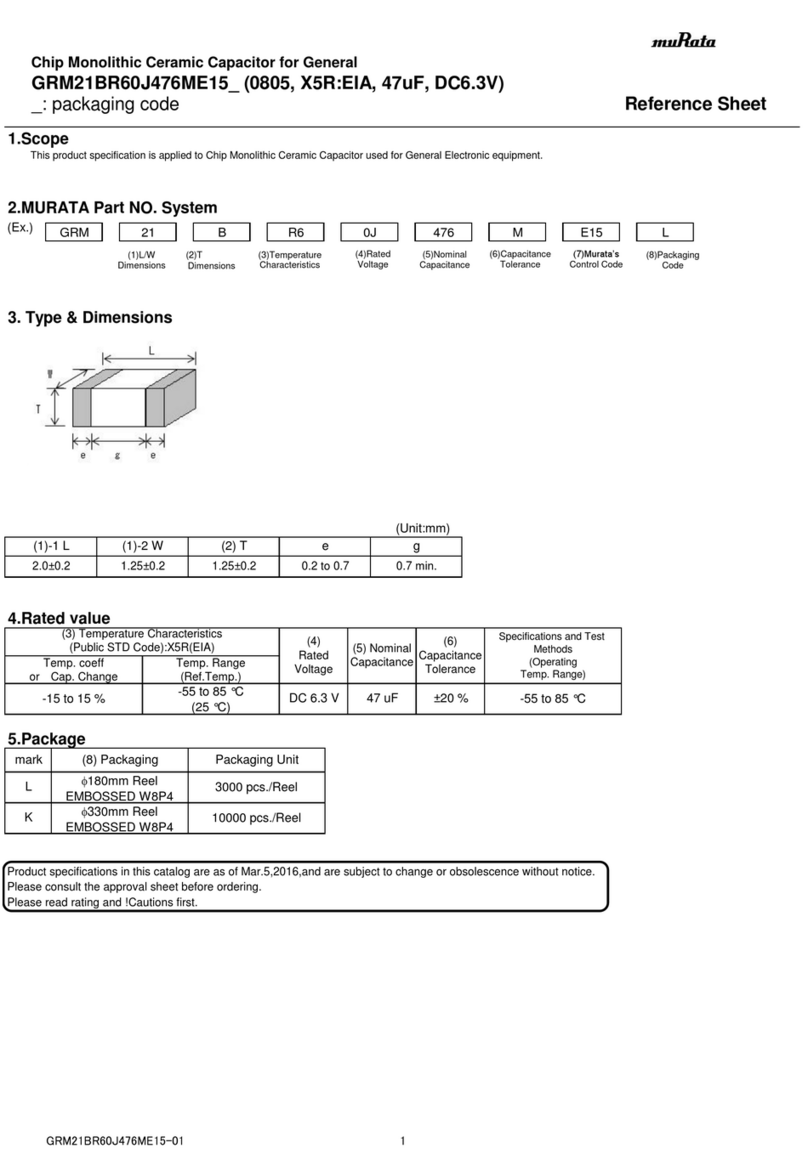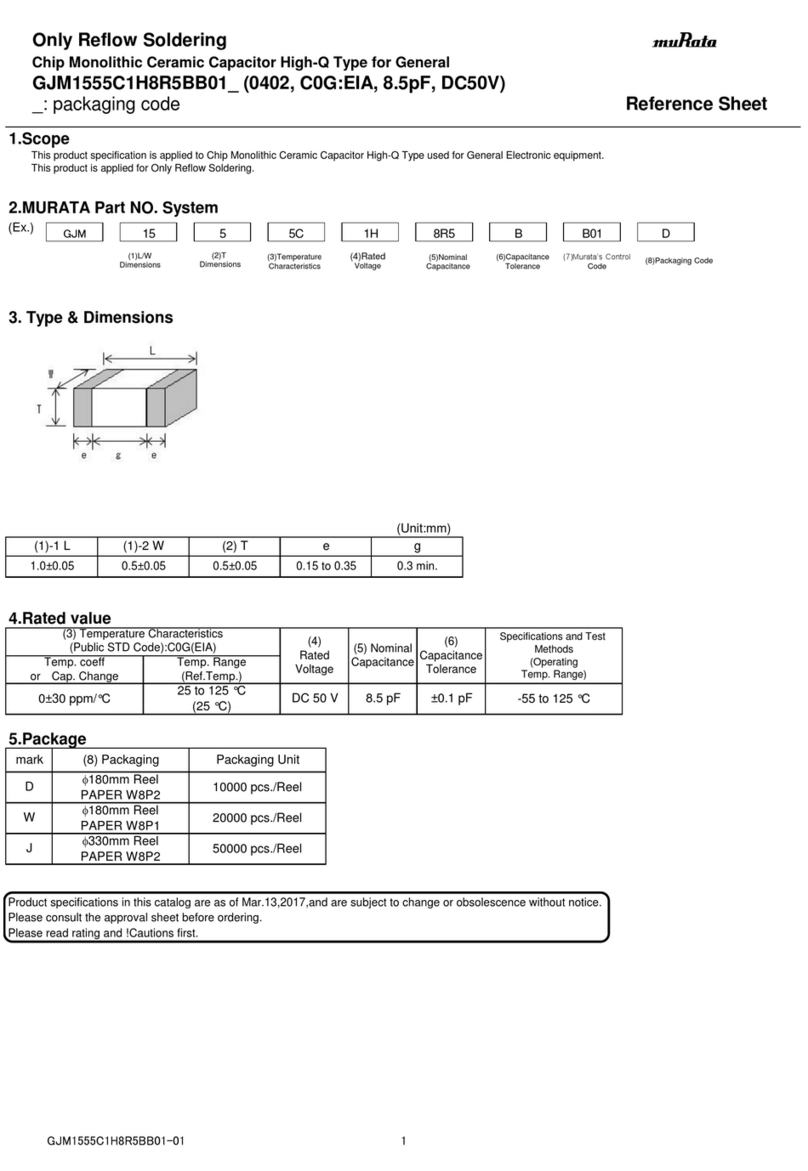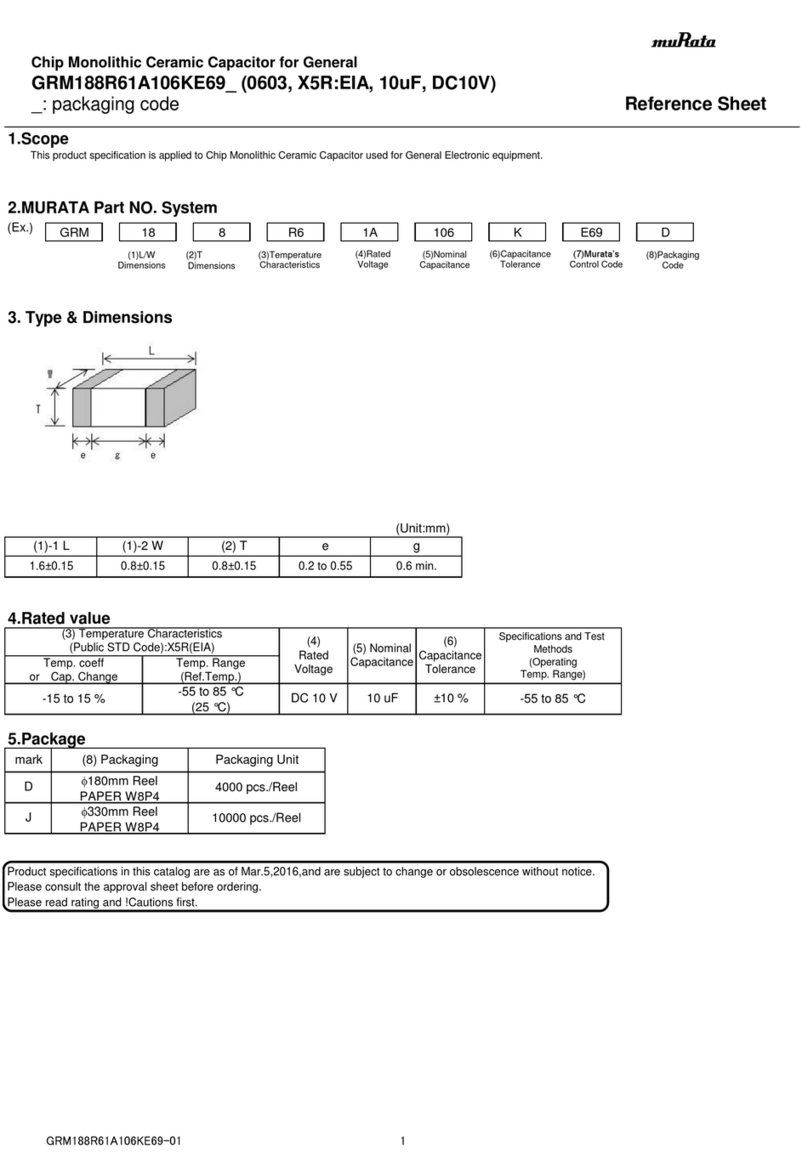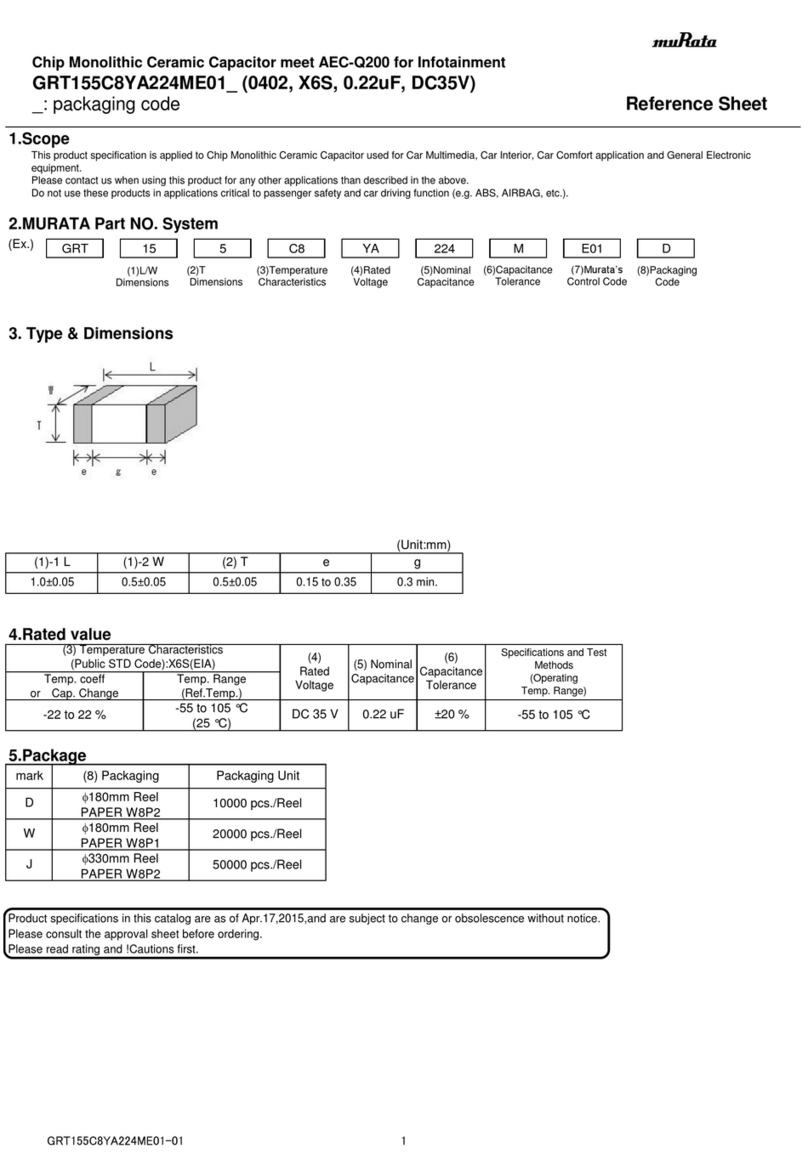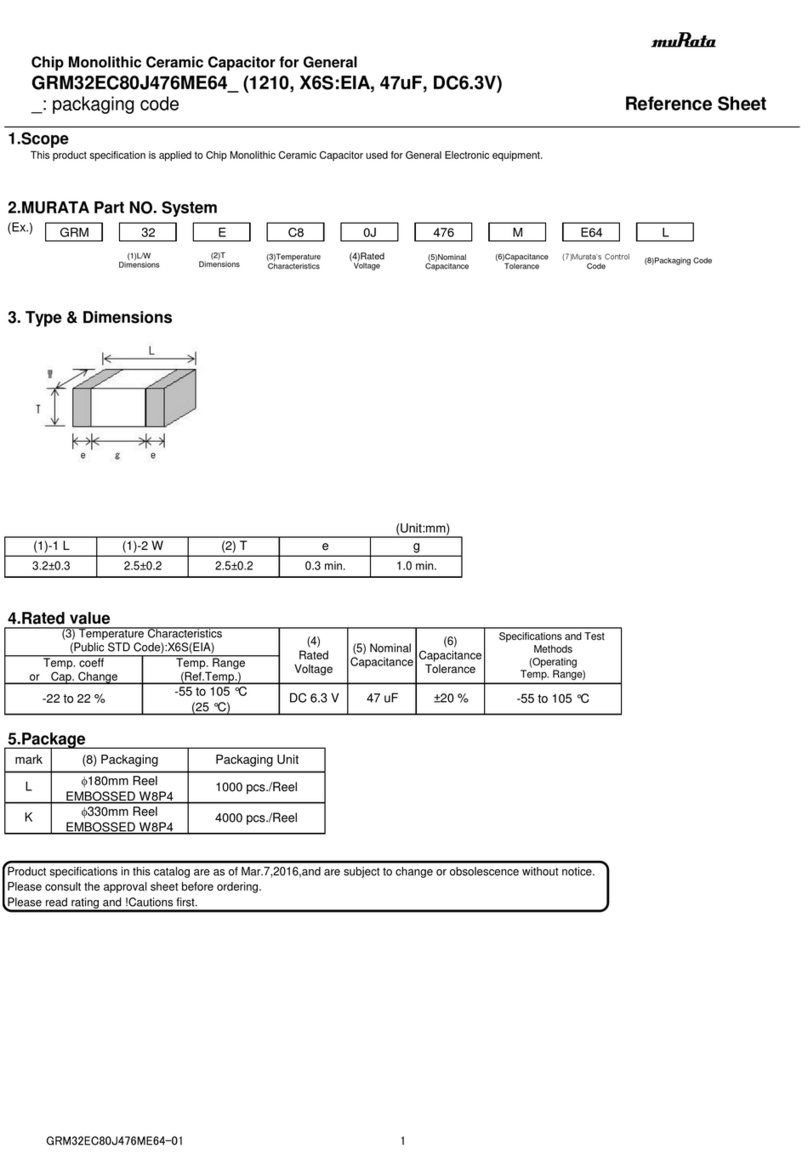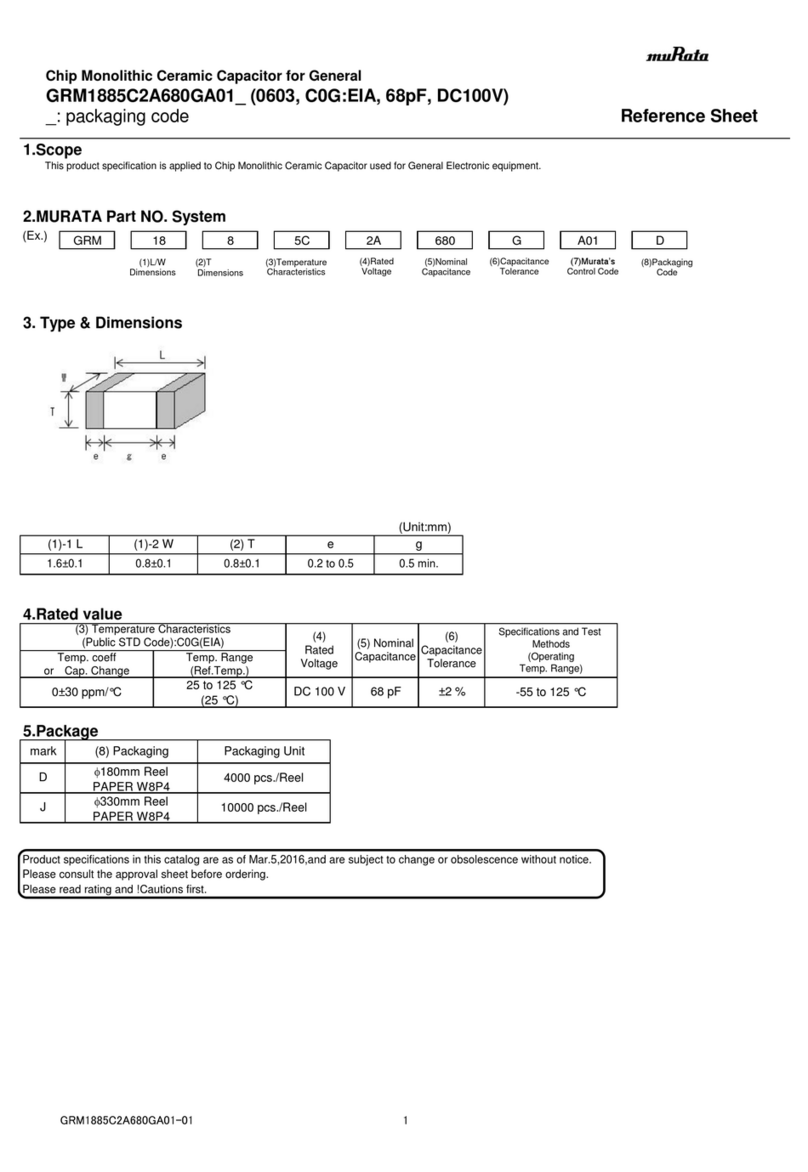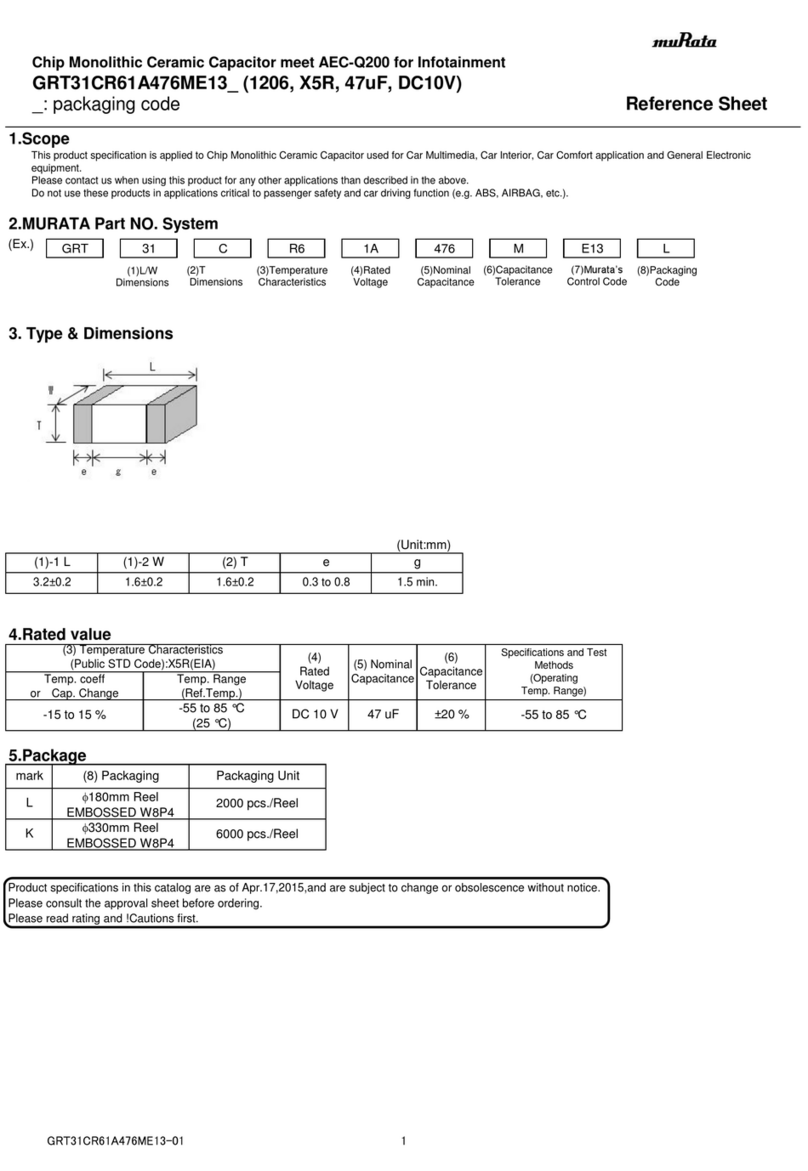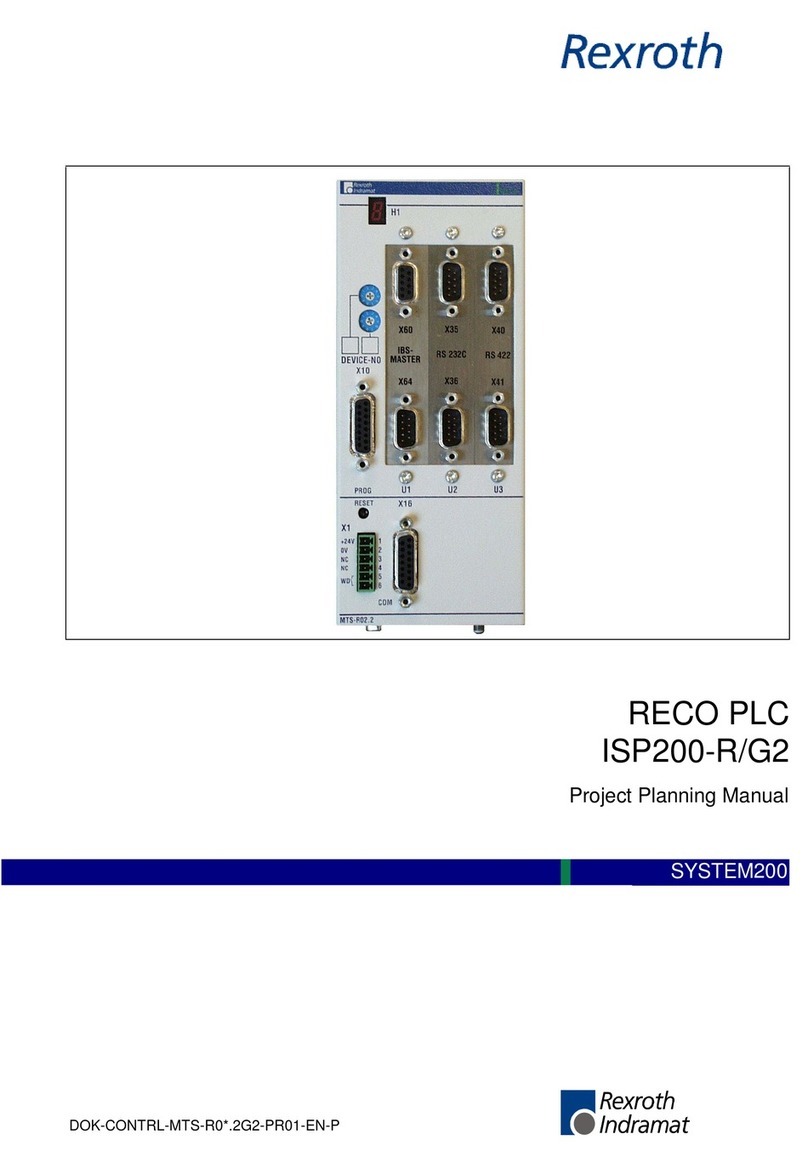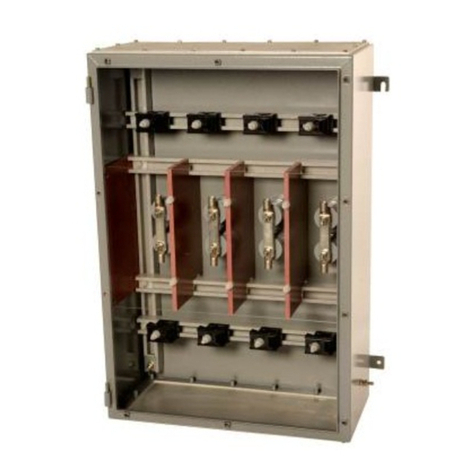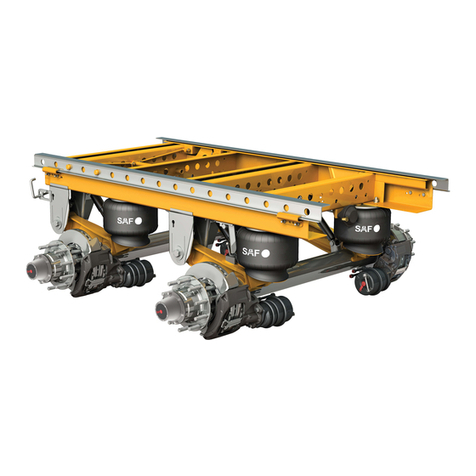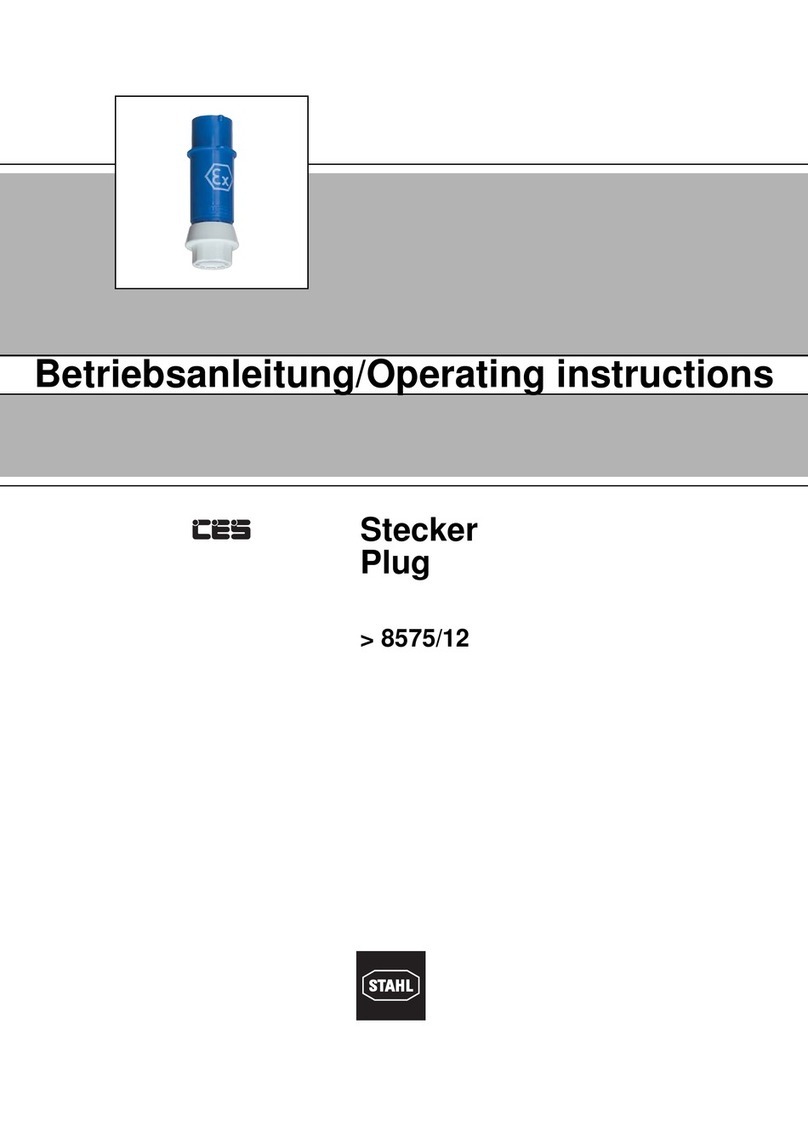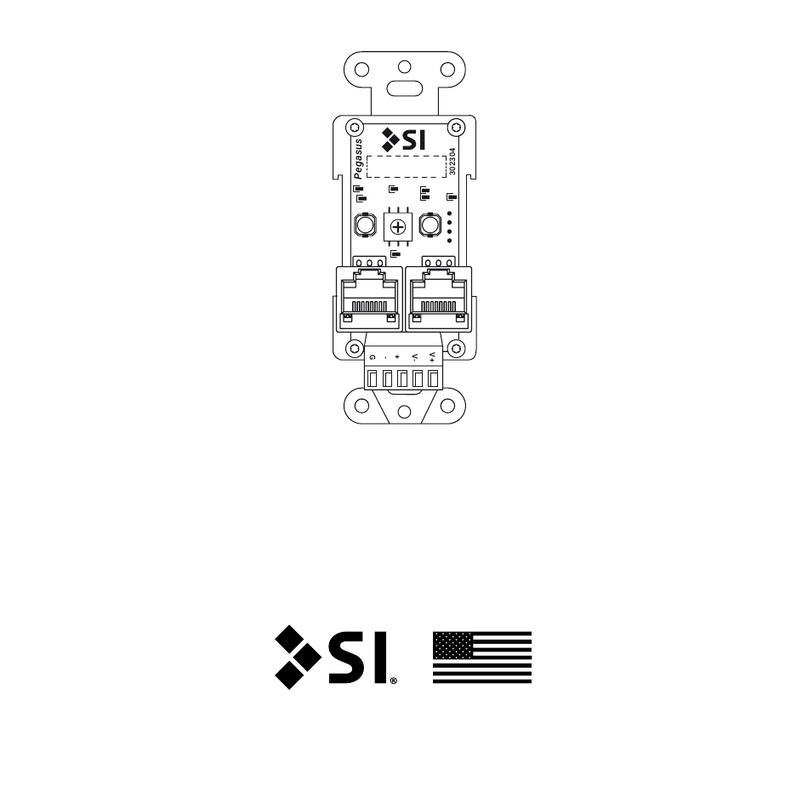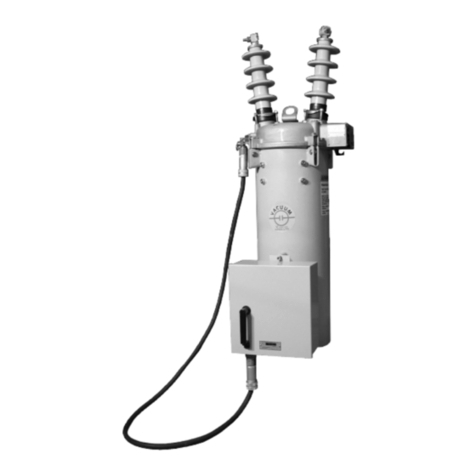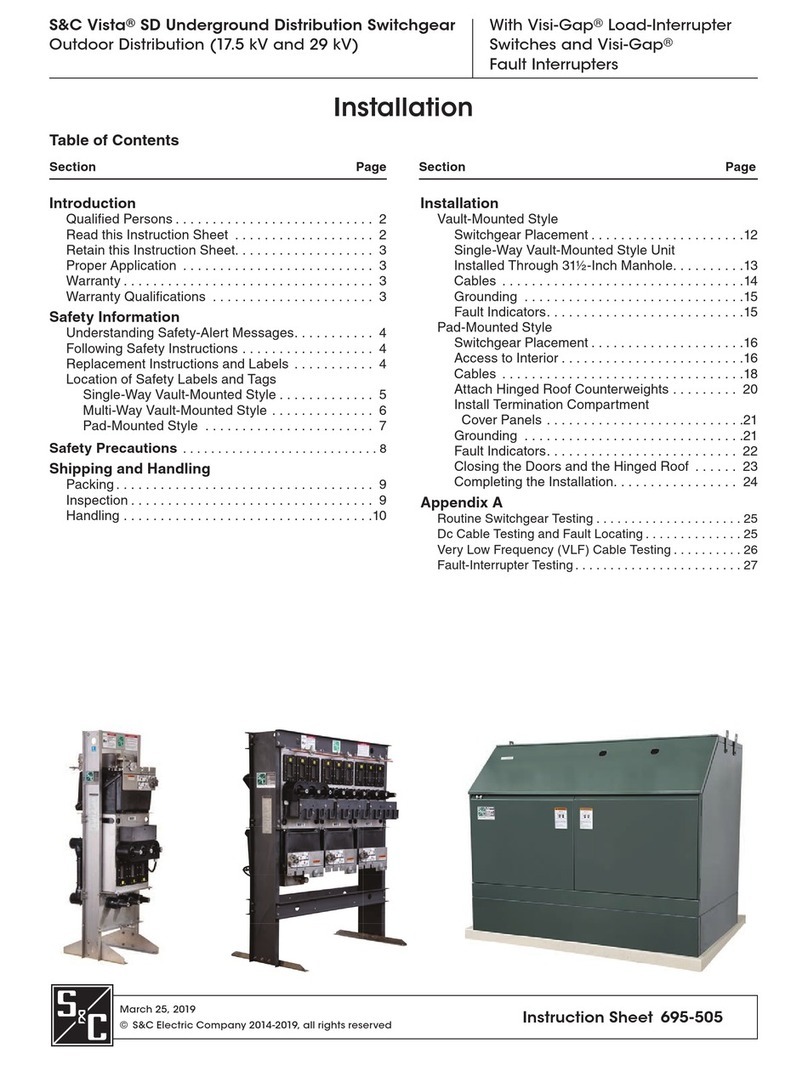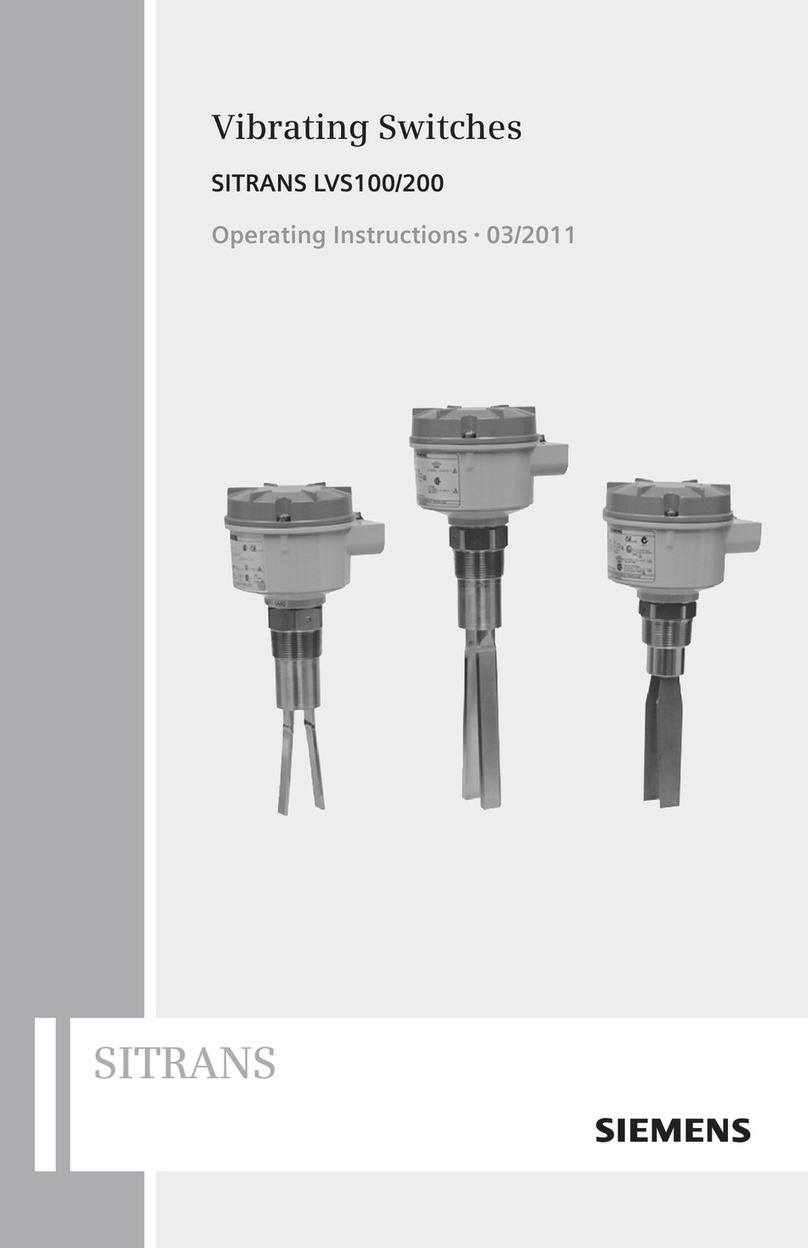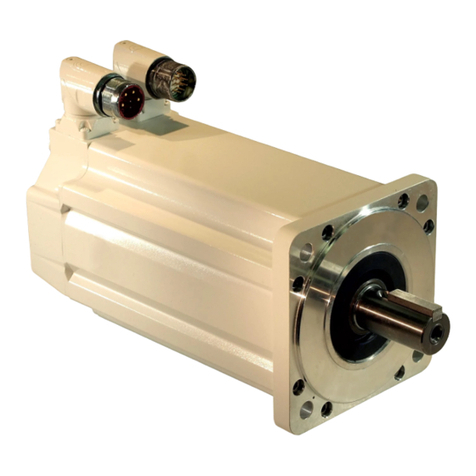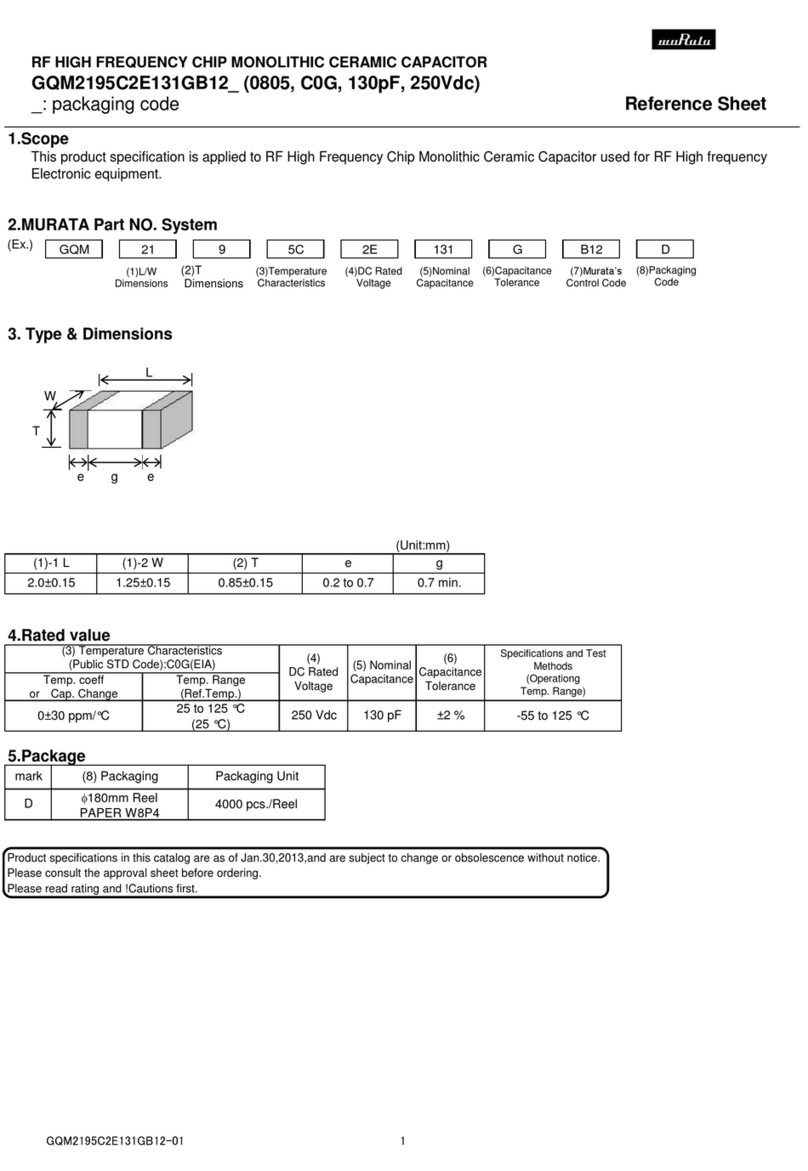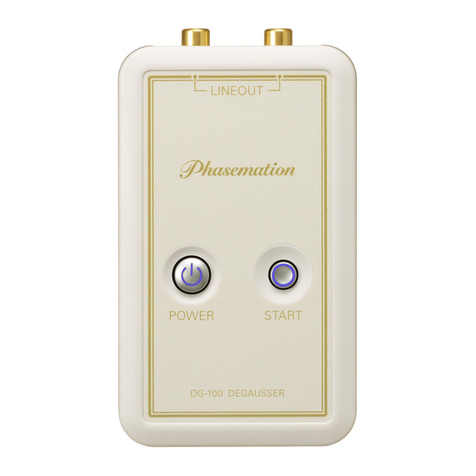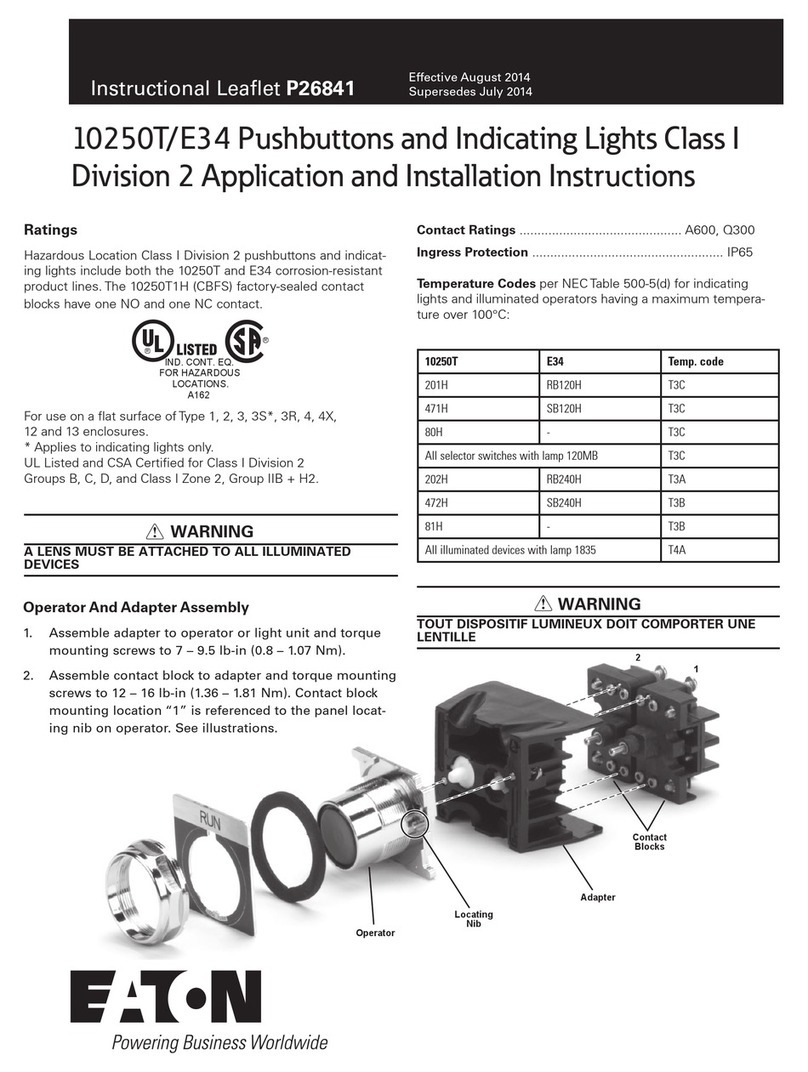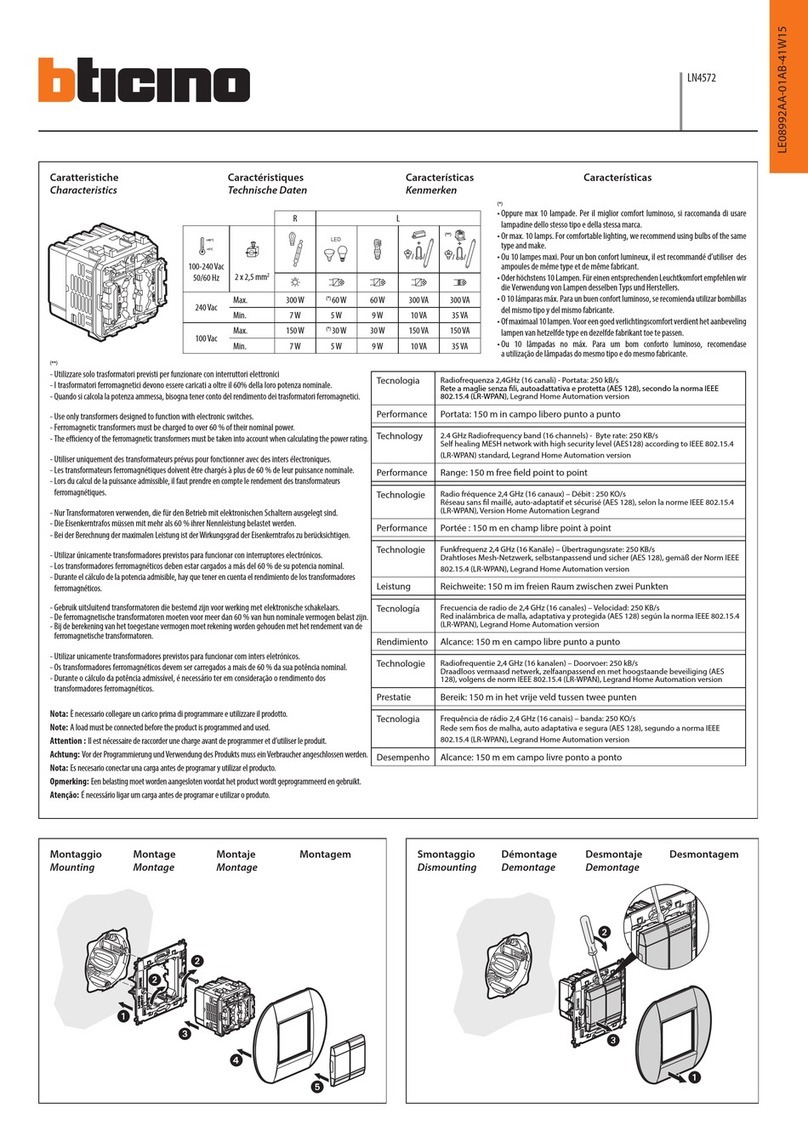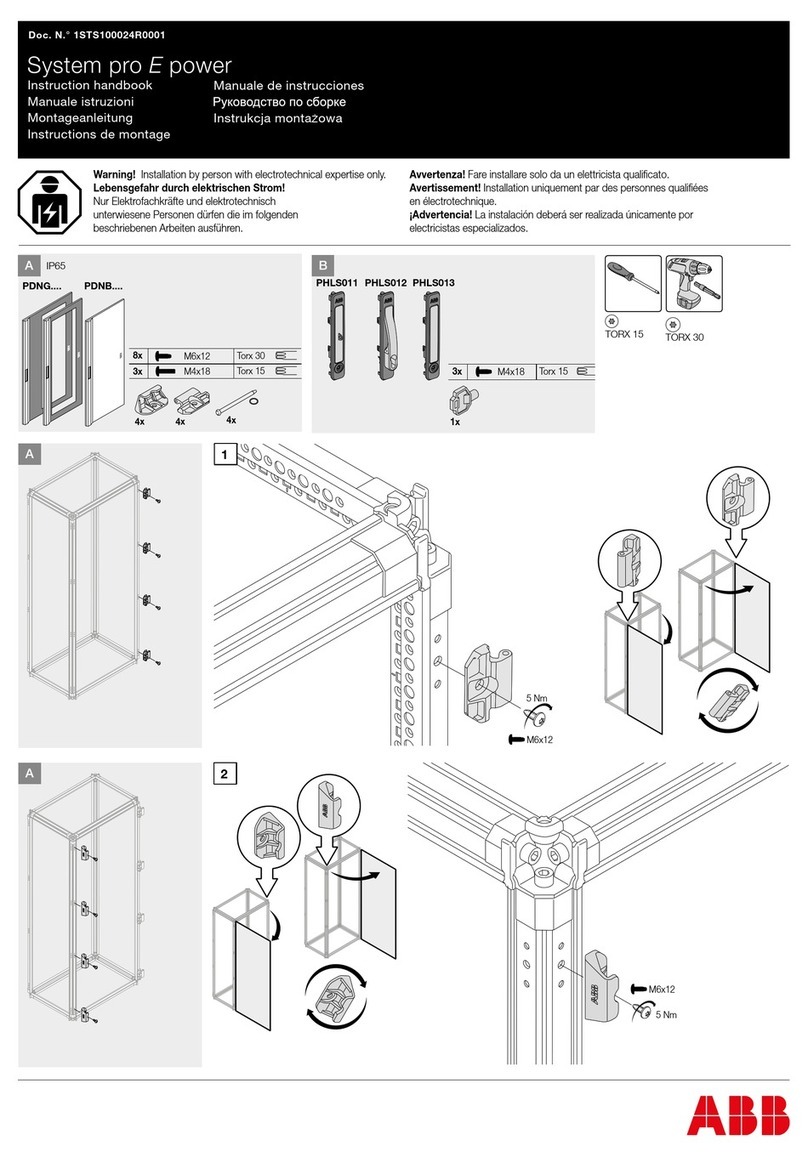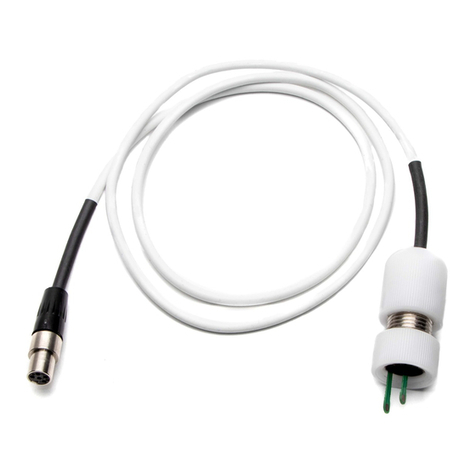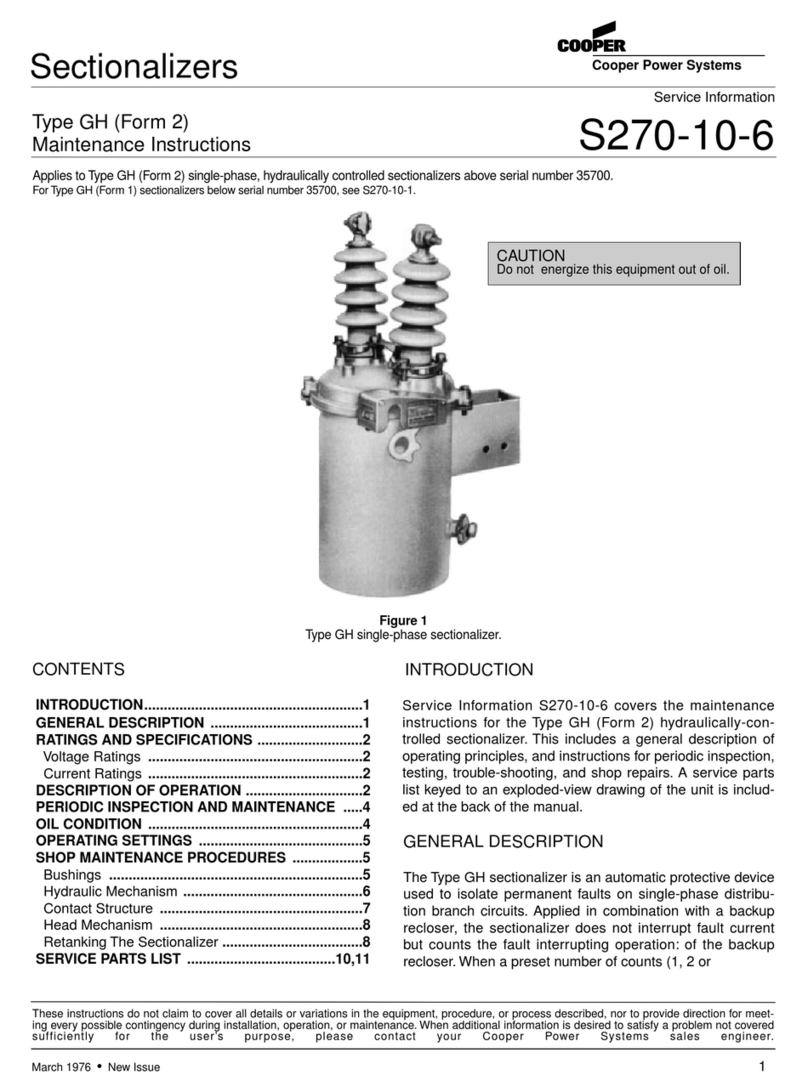
11 Vibration Appearance No defects or abnormalities.
Solder the capacitor on the test jig (glass epoxy board) in the
Resistance same manner and under the same conditions as (10).
Capacitance Within the specified tolerance. The capacitor should be subjected to a simple harmonic
motion having a total amplitude of 1.5mm, the frequency
D.F. B1,R1,B3,R6,R7,C6,C7,C8,E7,D7 : 0.1 max.
being varied uniformly between the approximate limits of 10
D8,GRM31CR60J107 : 0.15 max
and 55Hz. The frequency range, from 10 to 55Hz and return
GRM31CR71E106 : 0.125 max
to 10Hz, should be traversed in approximately 1 minute. This
motion should be applied for a period of 2 hours in each 3
mutually perpendicular directions(total of 6 hours).
12 Deflection Appearance No defects or abnormalities.
Solder the capacitor on the test jig (glass epoxy board)
shown in Fig.1 using an eutectic solder. Then apply a force
in the direction shown in Fig 2 for 5+/-1 sec. The soldering
Change should be done by the reflow method and should be
conducted with care so that the soldering is uniform and free
of defects such as heat shock.
13 Solderability 75% of the terminations is to be soldered evenly Immerse the capacitor ina solution of ethanol (JIS-K-8101)
of Termination and continuously. and rosin (JIS-K-5902) (25% rosin in weight propotion) .
Preheat at 80 to 120℃for 10 to 30 seconds.
After preheating, immerse in an eutectic solder solution for
2+/-0.5 seconds at 230+/-5℃or Sn-3.0Ag-0.5Cu solder
solution for 2+/-0.5 seconds at 245+/-5.
14 Resistance to Appearance No defects or abnormalities.
Preheat the capacitor at 120 to 150℃for 1 minute.
Soldering Heat Immerse the capacitor in an eutectic solder solution* or
Capacitance
B1,R1,B3,R6,R7,C6,C7,C8,E7,D7,D8 : Within ±7.5% Sn-3.0Ag-0.5Cu solder solution at 270+/-5℃for
Change GRM188B30J106M : Within ±12.5% 10+/-0.5 seconds. Set at room temperature for 24+/-2
*Not apply to GRM02
D.F. B1,R1,B3,R6,R7,C6,C7,C8,E7,D7 : 0.1 max.
D8,GRM31CR60J107 : 0.15 max · Initial measurement
GRM31CR71E106 : 0.125 max
Perform a heat treatment at 150+0/-10°C for one hour and then set at room
temperature for 24±2 hours.
Perform the initial measurement.
*Preheating for GRM32/43/55
Temperature Appearance No defects or abnormalities. Fix the capacitor to the supporting jig in the same
Sudden manner and under the same conditions as (10).
Change Capacitance B1,R1,B3,R6,R7,C6,C7,C8,D7,D8 : Within ±7.5% Perform the five cycles according to the four heat
Change E7 : Within ±30% treatments shown in the following table.
Set for 24+/-2 hours at room temperature, then measure.
D.F. B1,R1,B3,R6,R7,C6,C7,C8,E7,D7 : 0.1 max.
D8,GRM31CR60J107 : 0.15 max
GRM31CR71E106 : 0.125 max
F1,F5 : 0.2 max
I.R.
More than 50Ω ∙F ・Initial measurement
Perform a heat treatment at 150+0/-10°C for one hour and then set
at room temperature for 24±2 hours.
Perform the initial measurement.
Perform a heat treatment and then let sit for 24+/-2 hours at room
temperature, then measure.
High Appearance No defects or abnormalities. Apply the rated voltage at 40+/-2℃and 90 to 95%
Temperature humidity for 500+/-12 hours. The charge/discharge
High Capacitance B1,R1,B3,R6,R7,C6,C7,C8,E7,D7,D8 : Within ±12.5% current is less than 50mA.
Humidity Change F1,F5 : Within ±30%
D.F. B1,R1,B3,R6,R7,C6,C7,C8,E7,D7,D8 : 0.2 max.
Perform a heat treatment at 150+0/-10°C for one hour and then let sit
F1,F5 : 0.4 max for 24±2 hours at room temperature.
Perform the initial measurement.
More than 12.5Ω ∙F Perform a heat treatment and then let sit for 24+/-2 hours at room
temperature, then measure.
17 Durability Appearance No defects or abnormalities. Apply 150% of the rated voltage for 1000+/-12 hours at
the maximum operating temperature +/-3℃.
Capacitance B1,R1,B3,R6,R7,C6,C7,C8,E7,D7,D8 : Within ±12.5% The charge/ discharge current is less than 50mA.
Change F1,F5 : Within ±30%
Perform a heat treatment at 150+0/-10°C for one hour and then let sit
D.F. B1,R1,B3,R6,R7,C6,C7,C8,E7,D7,D8 : 0.2 max. for 24±2 hours at room temperature.
F1,F5 : 0.4 max
Perform the initial measurement.
Perform a heat treatment and then let sit for 24+/-2 hours at room
temperature, then measure.
■SPECIFICATIONS AND TEST METHODS
Min.
Operating Temp.+0/-3
Max.
Operating Temp.+3/-0
